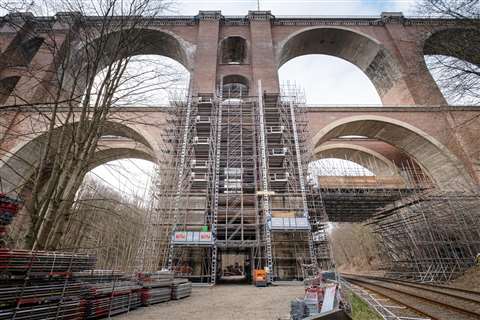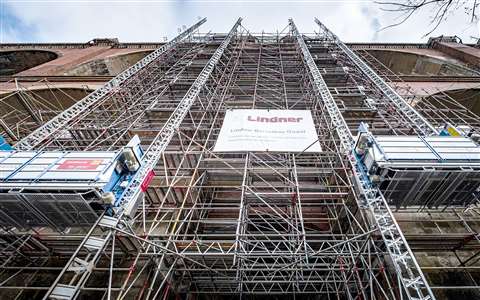Geda transport platforms match soaring brick-bridge renovation
13 December 2022
 Four Geda 1500 Z/ZP transport platforms on Germany’s Elster Viaduct can carry 4,400 pounds or seven passengers on a 14 x 5 foot platform. (Photo: GEDA GmbH)
Four Geda 1500 Z/ZP transport platforms on Germany’s Elster Viaduct can carry 4,400 pounds or seven passengers on a 14 x 5 foot platform. (Photo: GEDA GmbH)
Four Geda transport platforms are putting lots of capacity into a small space in the renovation of the historic Elster Viaduct in the German state of Saxony. The rail support structure of the viaduct is being replaced and the brickwork renovated. In addition, a crossover and an electronic signal box will be built.
The Elster Viaduct spans the White Elster river and Gera South-Weischlitz railway line that parallels the river. At 223 feet (68 meters) high and of 886 feet (270 meters) long, the railway bridge is the world’s second-largest brick bridge in the world. The foundation stone was laid in 1846, and up to 800 workers used 12 million bricks to build the viaduct. Various renovations and repairs followed, and even a partial reconstruction after the central viaduct pillar was blown up in World War II.
To secure the monument’s stability under modern rail traffic, the brickwork will be extensively renovated and the track base rebuilt. Water ingress into the structure necessitates repair of the sealing and drains.
While one of the tracks will be accessible for most of the work period, there will be instances where the section will have to be fully closed.
Not only is the listed historical structure a sensitivity, the bridge is located in several biotopes, nature reserves and conservation areas so environmental care also plays an important role. An approximately 98 feet (30 meter) long suspended bridge was installed between the supports of the viaduct for transporting materials across the White Elster.
Vertical transport solution
There is very little space available on site, which makes horizontal transport and erecting scaffolding difficult. But difficulties with horizontal transport are offset by easy vertical transport.
Four Geda 1500 Z/ZP transport platforms will be used throughout the five-year project. In the first step, these construction hoists will primarily be transporting materials for setting up the scaffolding. The responsible company Lindner Gerüstbau GmbH from Kolkwitz was hired to implement this giant project. The Geda transport platforms are hired from LEX, part of the Lindner Group.
Transport platforms match the task
 (Photo: GEDA GmbH)
(Photo: GEDA GmbH)
After the scaffolding is up the Geda transport platforms can be used either as material hoists or as transport platforms for passengers and materials. The 1500 Z/ZP series distributes its load capacity of 4,400 pounds (2,000 kilograms) or seven passengers across two masts (Geda’s Uni-X-Mast system), keeping anchoring forces low and the platform stable during travel.
When the transport platform control is activated, passengers can be transported with a lifting speed of 39 feet (12 meters) per minute. If only materials are transported, the Geda 1500 Z/ZP automatically switches to material hoist mode with a faster speed of 79 feet (24 meters) per minute. The Elster Viaduct will not test the 1500 Z/ZP’s maximum lifting height of 328 feet (100 meters).
Productivity and safety mods
Three platforms on the job are fitted with Geda’s I platform, one of 14 platforms available with the modular system. The I platform measures 14 feet x 5 feet (4.35 meters x 1.65 meters) to transport the large volume of bulky materials required for the work.
Safe transfer from hoist to landing platform resulted in development of not just one, but two new landing-level safety gates. Sixteen Comfort landing-level safety gates were installed for each hoist.
 (Photo: GEDA GmbH)
(Photo: GEDA GmbH)
STAY CONNECTED



Receive the information you need when you need it through our world-leading magazines, newsletters and daily briefings.
CONNECT WITH THE TEAM











